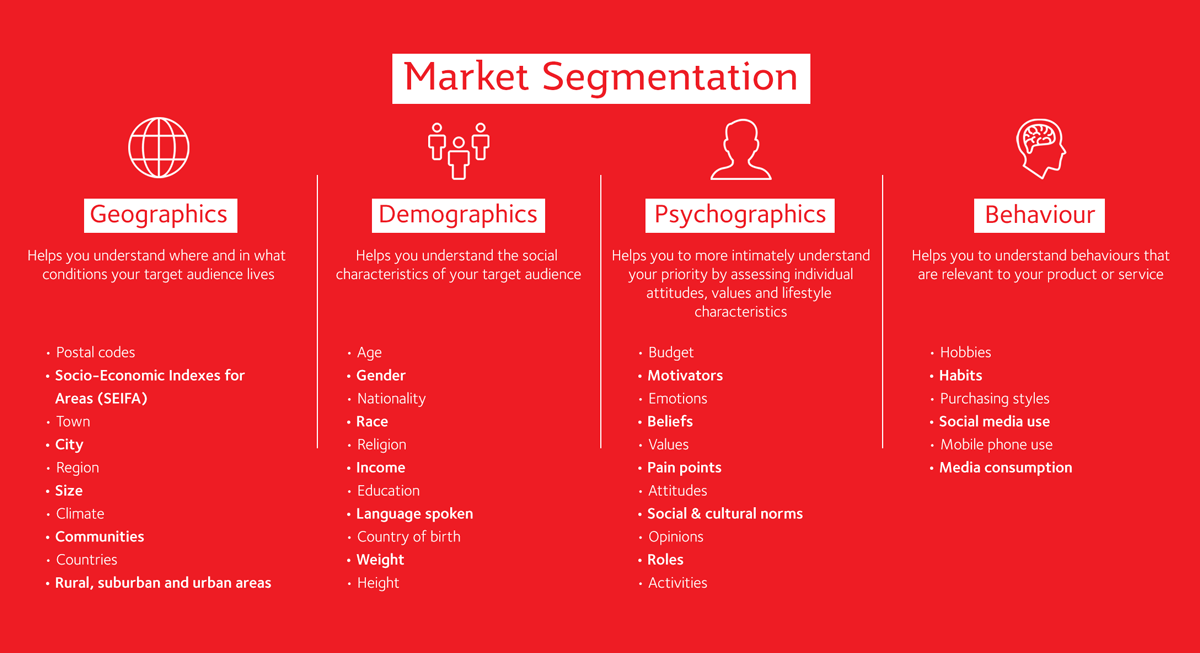5 steps to success
Segmentation, a marketing tool used for over 60 years, enables us to gain deeper insights and can help to guide thinking ensuring programs and campaigns meet the needs and wants of more people. But how can we do this most effectively? Our team at Social Marketing @ Griffith shows you how you can do this in 5 easy steps! Read on to learn more…
Segmenting is the crucial first step in the strategic and social marketing process. All customers are not the same.
Whether you are for-profit or not for -profit, we are all trying to gain the attention of people who will be interested in our product and/or service offerings. Whilst no two people are ever entirely the same, we can use tools to find some similarities to help guide our strategic thinking.
By understanding the preferences, interests, motivations and behaviours of groups of individuals we can more effectively engage more people. Segmentation allows us to think of the market we serve as groups of people rather than one whole market.
The aim of marketing is to know the customer so well, that the product or service fits them and sells itself. ~ Peter Drucker
One size does not fit all
Segmentation in social marketing reduces costs and time and avoids costly new product/service failures. Segmentation enables you to: (1) become clear about the type of people you are seeking to engage, (2) build a product/service that is relevant to your audience, (3) determine how and where you can attract and reach your segments, and (4) create communication that resonates with and more effectively reaches your segments.
Segmenting your market in 5 simple steps
Market segmentation is a craft. Conducting market segmentation requires a structured approach. This guide is written to provide a step-by-step approach to market segmentation. Our five-step process can help you improve your segmentation efforts or help you get started in segmenting your audience.
STEP ONE: Establish a target audience
The first step requires you to identify a broader target audience. It is crucial in marketing to decide which consumers to prioritise and your first step is to identify who it is that you are more broadly after. A critical question to ask yourself: who is your priority audience?
For example, senior citizens, parents, teachers, teenagers or families could all be classified as broader target audiences. The important thing to note is that a target audience does not equate to a market segment. These are two different concepts. A target audience is a broader representation and it is your job to identify segments within that target audience.
STEP TWO: Identify characteristics that matter to your target audience
After you have identified your target audience, you will need to start to gain a deeper understanding of the people you seek to serve. We separate these unique characteristics into four key bases namely demographics, geographic, psychographics and behaviour. Let’s look at some examples of each:

STEP THREE: Enriching segments by building personas
Personas can give a concrete representation of user groups identified. Each identified persona will require a meaningful and descriptive name possibly accompanied by a vivid short description, which in turn guides managerial decision making. A picture says more than a 1000 words and finding a representative image to bring your persona to life is necessary.
Developing a persona involves building on the initially developed segments. Enriching can happen in a number of ways such as talking to actual customers, conversations with staff, and continuously collecting more data on your customers. Work collaboratively with your team and customers to create personas that capture the current thinking about who your customer groups are.

The more accurate the persona the better the understanding of what type of product/service and communication will resonate with the persona.
STEP FOUR: Assess segments
In this step, we evaluate whether personas represent a large enough audience and ensure that they are reachable. Resources will always dictate how many personas you can tailor service and communication solutions to. With all these factors taken into account, this will assist in determining whether the personas should be used to guide program planning.
Answer the questions in the table below to identify one or more viable segment(s).

STEP FIVE: Target one or more personas
The final stage requires ensuring the wants and needs of each chosen persona are taken into account and catered to. Each chosen persona is likely to require a unique product/service and communication solution tailored to their individual specific needs and wants. Select wisely which personas are the best fit for your product/service.
Takeaway message
By applying segmentation, you can gain a stronger understanding of more of the different people you are seeking to engage with. Equipped with a deeper understanding you are much better placed to tailor your product/service offerings to better meet the needs and wants of more of the people you are seeking to serve.
To ensure maximum quality in your segmentation practices, download our Market Segmentation How-to for free.
Download the Market Segmentation How-to (FREE)

We collect your details to provide you with a range of resources and services to help you improve your marketing efforts. You will receive these and other communications via email. For more information about how we treat your data, check out our privacy policy.
We collect your details to provide you with a range of resources and services to help you improve your marketing efforts. You will receive these and other communications via email. For more information about how we treat your data, check out our privacy policy.
Top 3 reasons to segment your audiences
Video by Heidi Keller at TEDxMontlakeCut
Many people have an aversion to separating, categorizing, and prioritizing the recipients of their programs and campaigns. Heidi Keller discusses the reasons why it is an essential planning tool for program planners with small budgets and big ideas: because it works!

